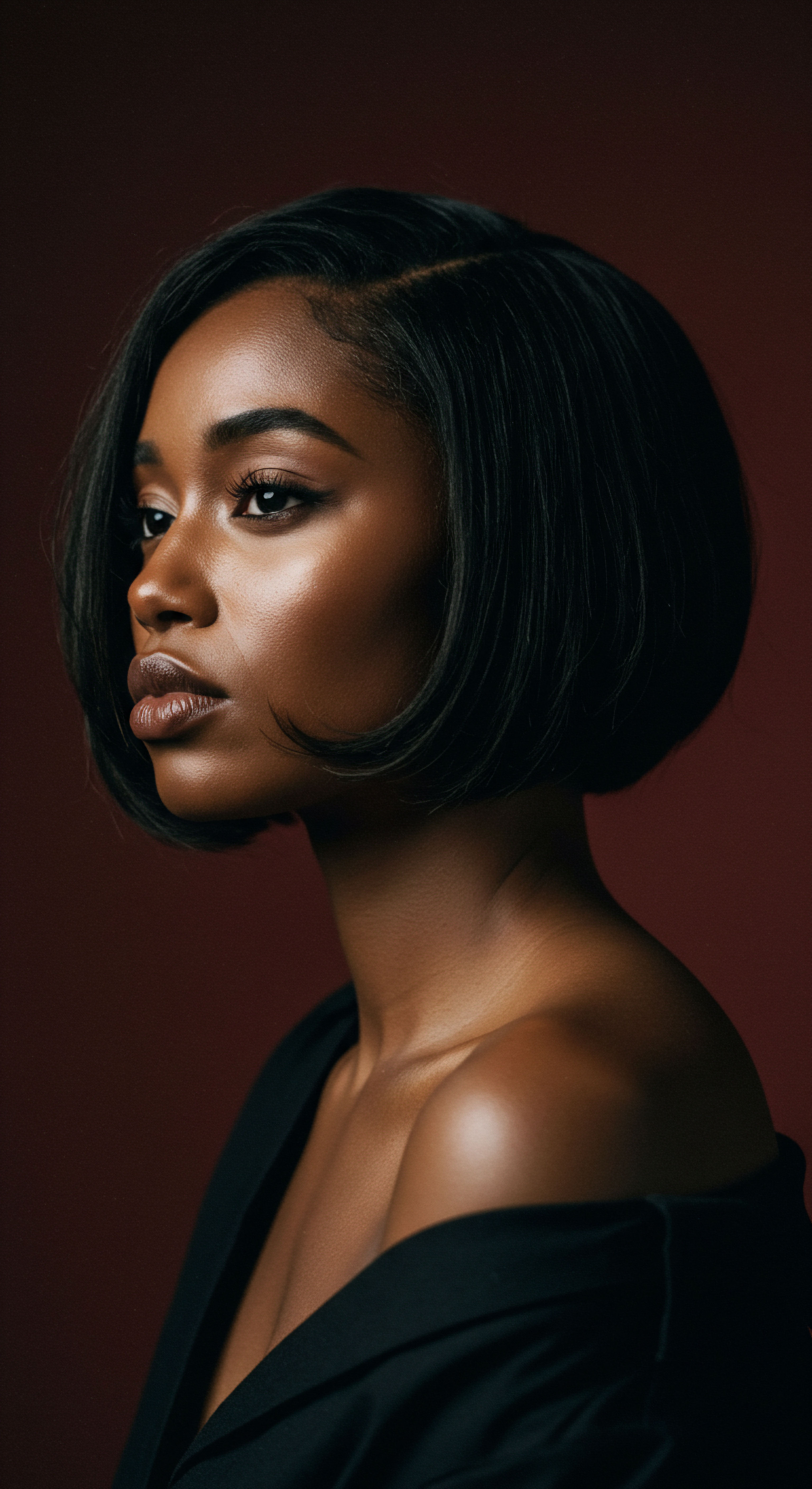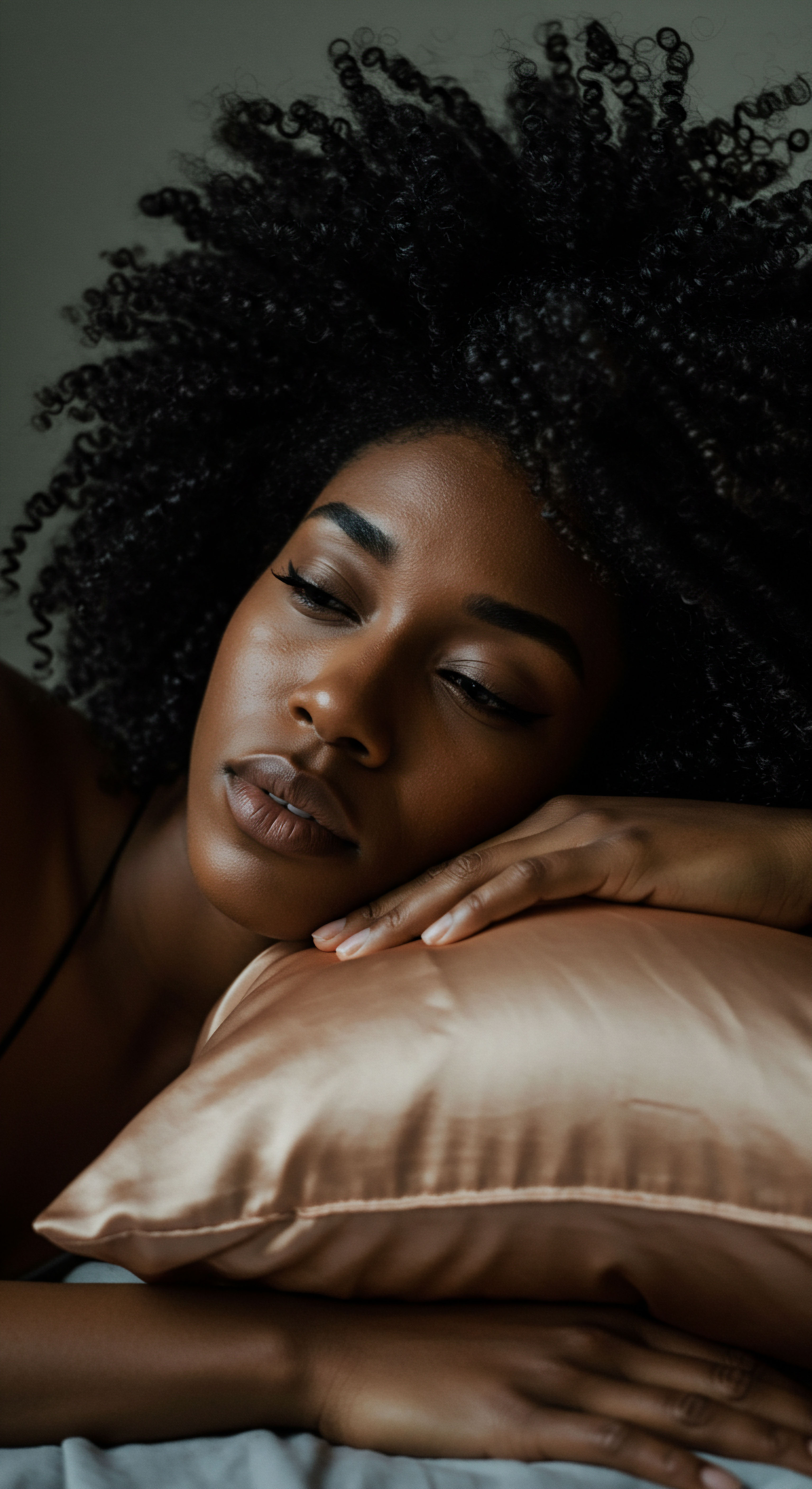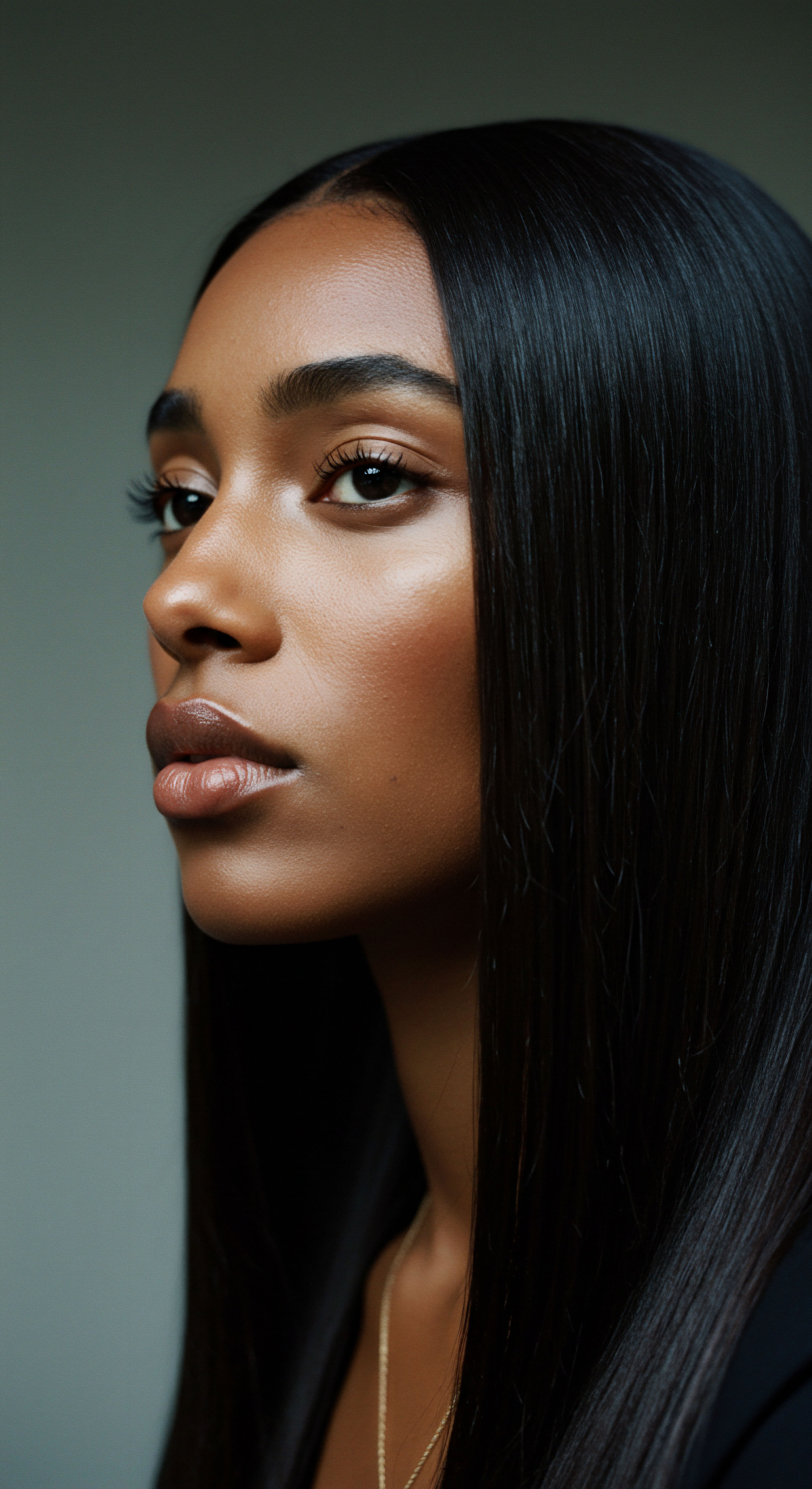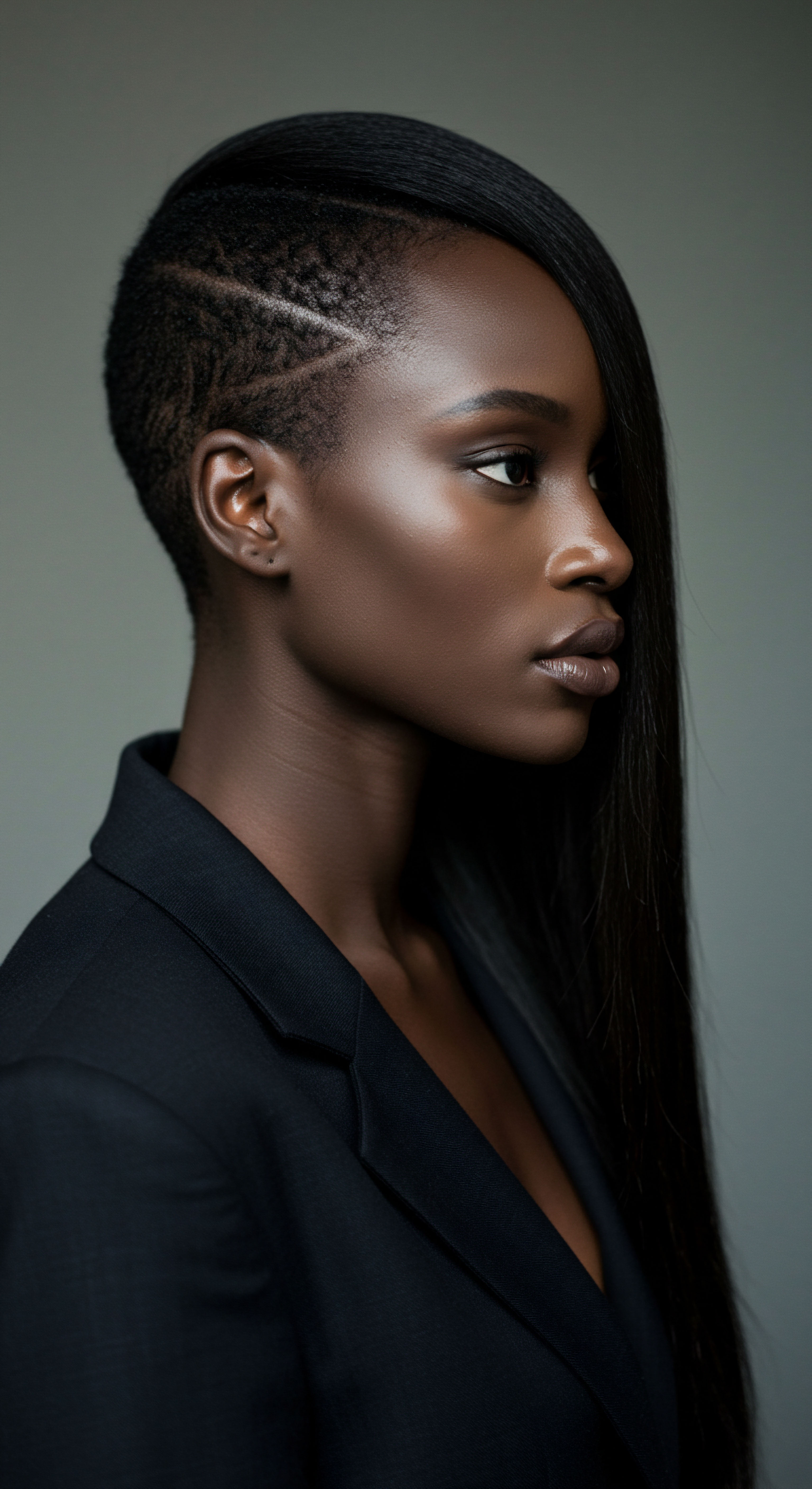
Roots
There resides within each strand of hair a quiet history, a testament to resilience, and a delicate blueprint for its very being. For generations, the human experience has intertwined with the story of hair, a crowning glory, a cultural marker, a shield against the elements. Yet, in our daily lives, often without a second thought, we ask much of these delicate filaments. The nightly repose, a time meant for restoration, can paradoxically introduce forces that challenge hair’s intrinsic strength, particularly for those with textured hair, whose spirals and coils possess a distinct architectural marvel and vulnerability.
Consider the whisper of a pillowcase against a sleeping head, a seemingly benign interaction. For many, this subtle contact translates into a relentless, repetitive mechanical stress, particularly for hair that curls and bends, creating more points of potential abrasion. Understanding whether a nightly covering can truly stand as a guardian against this silent adversary requires a journey into the fundamental nature of hair itself, its structure, and the subtle dance of forces that can lead to its undoing.

The Hair Strand’s Protective Layers
Each individual hair strand, whether a fine whisper or a robust coil, stands as a marvel of biological engineering. At its core, protected by layers, lies the Cortex, a region composed primarily of keratin proteins, granting hair its strength and elasticity. This inner sanctuary is enveloped by the Cuticle, an outer protective sheath formed by overlapping, scale-like cells, much like shingles on a roof. These scales lie flat and smooth on healthy hair, reflecting light and allowing strands to glide past one another with minimal impedance.
The integrity of this cuticle layer is paramount. When these scales are disturbed, lifted, or chipped, the hair becomes susceptible. It loses its smooth surface, leading to increased friction, which in turn can snag and abrade, initiating a cycle of damage that progresses deeper into the hair shaft.
This surface compromise diminishes hair’s natural luster and contributes to a rough, dull sensation. The microscopic world of the hair shaft reveals that even seemingly minor interactions can, over time, lead to significant structural weakening.

Unpacking Breakage Beyond the Surface
Breakage is a term often used broadly, yet its manifestation within textured hair presents a particular complexity. It is not merely a strand snapping; it is a symptom of accumulated strain. The unique helical structure of textured hair, from loose waves to tight coils, means that each bend and curve presents a potential stress point. Unlike straight strands that offer a more uniform surface, coily hair has more exposed cuticle edges along its many turns, making it inherently more prone to mechanical damage from external forces.
Hair breakage, particularly in textured hair, is often a cumulative result of external forces persistently challenging the strand’s delicate structural integrity.
When hair is subjected to constant rubbing, pulling, or compression, these cuticle scales can lift and eventually break away, exposing the more vulnerable cortex. This is where the term ‘breakage’ truly finds its meaning, as the internal protein structures become compromised, diminishing the hair’s tensile strength and elasticity. This structural weakening makes the hair more susceptible to snapping under even slight tension, a common observation for those waking from a night of unrestrained hair movement.

The Silent Erosion of Nighttime Friction
The hours spent in slumber, a period we associate with repose, can ironically become a battlefield for hair. As one shifts and turns, the hair rubs against the pillowcase. Common bedding materials, such as cotton, possess a surface texture that, while soft to the touch, can be surprisingly abrasive to delicate hair cuticles. This continuous mechanical interaction generates friction, a force that opposes motion, creating resistance against the hair shaft.
This friction acts as a silent, persistent erosive agent. It causes the hair strands to snag, tangle, and ultimately leads to the lifting and fracturing of the cuticle scales. For textured hair, where strands naturally intertwine and coils can catch on rough surfaces, this effect is amplified.
The result is often the unwelcome sight of loose hairs on the pillow, frizz, and a dullness that speaks to the hair’s compromised surface. Understanding these foundational elements of hair structure and the mechanics of damage lays the groundwork for appreciating the protective potential of nightly coverings.

Ritual
Stepping from the foundational understanding of hair’s delicate architecture, we now turn our attention to the deliberate acts of care, the mindful practices that safeguard its vitality. The question of nightly hair covering moves beyond mere inquiry; it beckons us into a realm of practical wisdom, where ancestral traditions meet modern insights to shape a routine of gentle protection. For those with textured hair, where each coil and curl holds a unique story of resilience and vulnerability, the nighttime ritual becomes a cornerstone of hair wellness. It is here, in the quiet hours, that a simple act can wield significant influence over hair’s morning disposition.
This section explores the various forms of nightly coverings, the science behind their efficacy, and the practical considerations that elevate a mere accessory to a true guardian of hair health. It is a dialogue about intentionality, about honoring hair through considered choices that shield it from the unseen forces of friction and moisture loss that can occur during sleep.

Choosing the Right Nightly Protector
The landscape of nighttime hair coverings offers a spectrum of choices, each with distinct properties. The most widely recognized are bonnets, scarves, and specialized pillowcases. While all aim to create a protective barrier, their material composition largely dictates their effectiveness.
- Bonnets ❉ Typically dome-shaped, these coverings offer a convenient way to contain hair, preventing it from rubbing against bedding. They are available in various materials.
- Scarves ❉ Versatile and adaptable, scarves allow for customized wrapping, accommodating diverse styles and lengths. Their effectiveness depends heavily on the fabric.
- Pillowcases ❉ An alternative to directly covering the hair, a specialized pillowcase changes the surface the hair rests upon, mitigating friction directly at the source.

The Material Science of Hair Protection
The heart of a nightly covering’s protective power lies in its material. Not all fabrics are created equal when it comes to hair’s delicate surface.
Silk and Satin stand as the undisputed champions in this arena. Their smooth, tightly woven fibers present minimal resistance to hair strands, allowing them to glide effortlessly across the surface. This dramatically reduces the mechanical friction that can lift and damage the hair’s cuticle layer. The difference in surface smoothness compared to conventional materials is stark.
In contrast, materials like Cotton, while breathable and soft for skin, possess a microscopic roughness. The individual cotton fibers have a more open weave and a textured surface that can snag on hair cuticles, leading to frizz, tangles, and ultimately, breakage. Beyond friction, cotton is also highly absorbent, meaning it can draw moisture from the hair, contributing to dryness and brittleness overnight. This is particularly detrimental for textured hair, which is often predisposed to dryness due to its structural characteristics.
The choice of fabric for nightly hair protection, especially silk or satin, hinges on its ability to minimize friction and preserve hair’s essential moisture.
Consider the following comparison of common materials ❉
| Fabric Type Silk |
| Surface Texture Extremely smooth, low friction |
| Moisture Absorption Very low |
| Friction Reduction High |
| Fabric Type Satin (polyester) |
| Surface Texture Smooth, low friction |
| Moisture Absorption Low |
| Friction Reduction High |
| Fabric Type Cotton |
| Surface Texture Rough, higher friction |
| Moisture Absorption High |
| Friction Reduction Low |
| Fabric Type Selecting materials with low friction and low absorbency supports hair health during sleep. |

How Do Coverings Protect Hair?
The protective mechanism of nightly hair coverings operates on two primary fronts ❉
- Reducing Mechanical Friction ❉ This is perhaps the most immediate and tangible benefit. By creating a smooth barrier between hair and bedding, bonnets, scarves, or silk pillowcases drastically reduce the abrasive forces that cause cuticle damage, tangles, and frizz. The hair slides rather than snags, preserving the integrity of the outer cuticle layer.
- Retaining Moisture ❉ Hair, especially textured hair, thrives on moisture. Dryness makes hair brittle and more prone to breakage. Cotton pillowcases, by their very nature, wick away moisture from hair and skin. Silk and satin, being less absorbent, help hair retain its natural oils and applied conditioning products, maintaining optimal hydration levels throughout the night. This sustained moisture helps keep hair supple and less vulnerable to mechanical stress.
Beyond these direct benefits, coverings also help maintain hairstyles, reducing the need for extensive restyling in the morning, which in itself minimizes manipulation and potential damage. They act as a cocoon, preserving the work of daily styling and conditioning.

Practical Application and Care for Lasting Benefit
To truly harness the protective power of nightly coverings, mindful application and care are essential.

How to Choose the Right Fit and Style?
For bonnets and scarves, ensuring a comfortable yet secure fit is paramount. Too tight, and it can cause tension on the hairline, potentially leading to breakage or even traction alopecia over time. Too loose, and it may slip off during sleep, negating its purpose.
Opt for adjustable bands or elastic that is gentle on the scalp. For those with very long or voluminous hair, a larger bonnet or a wrapping technique with a scarf might be more suitable to fully contain the hair without compressing it excessively.

Maintaining the Cleanliness of Your Covering
Just as one washes bedding, hair coverings require regular cleaning. Product buildup, natural oils, and environmental dust can accumulate on the fabric, which can then transfer back to the hair. Gentle washing, according to the material’s instructions, ensures the covering remains a clean, effective barrier. For silk, hand washing with a mild detergent and air drying helps preserve its delicate fibers and longevity.
The ritual of nightly hair covering is a small act with profound implications for hair health. It is a gentle yet powerful practice that honors the unique needs of textured hair, transforming the hours of sleep into a period of restorative protection against the everyday forces that can lead to breakage.

Relay
As we deepen our understanding of nightly hair coverings, the conversation extends beyond mere mechanics, inviting us to consider the intricate interplay of biological realities, cultural echoes, and even the subtle electrical forces at play. Can a nightly hair covering truly stand as a comprehensive defense against breakage, or does its influence extend into realms less immediately apparent? This inquiry calls for a multi-dimensional lens, one that recognizes the scientific precision behind hair’s vulnerability while honoring the rich, historical wisdom woven into protective practices.
Here, we bridge the gap between the visible act of covering and the invisible forces it counters, grounding our exploration in data and acknowledging the broader context that shapes our hair journeys.

Microscopic Vulnerability and Environmental Dance
The hair strand, a seemingly simple structure, holds a complex internal world. Beyond the overlapping cuticle scales, the hair’s cortex is a marvel of keratin proteins, cross-linked by disulfide bonds that grant hair its strength and shape. When the cuticle is compromised by repeated friction, these internal structures become exposed to environmental stressors, including fluctuations in humidity and temperature.
Hair’s mechanical properties are remarkably sensitive to its hydration state. When hair is dry, it becomes more rigid and brittle, making it more susceptible to snapping under stress. Conversely, excessively wet hair can also be vulnerable; water acts as a plasticizer, reducing the interactions between protein chains and making the hair more prone to damage from mechanical manipulation.
A nightly covering, particularly one made of silk or satin, helps maintain a more stable moisture environment around the hair, preventing extreme dryness or prolonged dampness that can weaken the hair shaft. This consistent hydration supports the hair’s natural elasticity, allowing it to bend and flex without fracturing.
Hair’s resilience against breakage is deeply tied to its hydration, a delicate balance nightly coverings help sustain by buffering environmental moisture fluctuations.

Electrostatic Forces and Fabric Choices
Beyond direct mechanical friction, another often overlooked factor in hair damage is the generation of static electricity. When different materials rub against each other, electrons can transfer, leading to a buildup of electrostatic charge. This phenomenon is particularly noticeable with certain synthetic fabrics. Charged hair strands repel each other, leading to frizz and tangles, which then increases the likelihood of mechanical damage when hair is later manipulated.
Research into the tribological performance of textiles, which examines friction and wear, has illuminated the varying degrees to which different fabrics generate static electricity when interacting with hair. For instance, a study investigating the electrostatic charge generated from the friction of wig cap textiles against human hair and skin revealed significant differences across materials. It found that polyester, particularly denser fibers, exhibited a relatively high friction coefficient against hair and generated a substantial electrostatic charge, reaching up to 615 volts in certain conditions. In contrast, cotton, acrylic, and chiffon generated considerably lower charges.
This suggests that while smoothness reduces friction, the material’s inherent electrical properties also play a role in hair’s nighttime well-being. This finding highlights a crucial distinction ❉ not all smooth fabrics are equally beneficial; their electrostatic properties also matter.

Cultural Resonance and Protective Heritage
The practice of covering hair at night, or indeed at any time, carries a profound cultural weight, particularly within Black and mixed-race communities. Far from a contemporary trend, this practice is deeply rooted in history, serving purposes beyond mere adornment. Across various African cultures, headwraps have long been symbols of status, spirituality, and identity. They also served a practical purpose, protecting hair from dust, sun, and environmental aggressors during daily activities.
During periods of enslavement in the Americas, head coverings, sometimes mandated as symbols of subservience, were defiantly transformed by Black women into expressions of resistance, cultural continuity, and personal dignity. This reclamation speaks to the enduring significance of hair coverings as a means of self-preservation and identity affirmation. The wisdom of these traditions, passed down through generations, intuitively understood the protective qualities of covering hair, long before modern science could quantify friction coefficients or cuticle damage. This historical context enriches our understanding of why nightly hair covering feels not just like a choice, but often a deeply connected practice for many with textured hair.

Does Nightly Covering Prevent Breakage? A Deeper Look
The cumulative evidence strongly suggests that nightly hair covering, particularly with smooth, non-absorbent materials, offers a substantial protective benefit against breakage. The mechanisms are multi-layered ❉ reducing mechanical friction, preserving moisture balance, and minimizing static electricity.
For textured hair, this preventative measure gains additional weight due to its inherent structural predispositions. Research from 2015, for instance, indicates that Black Hair Possesses a Thinner Cuticle Layer compared to other hair types, rendering it more prone to breakage. This structural characteristic means that the daily and nightly stresses, which might be minor for other hair types, can have a more pronounced impact on textured strands. Given this increased vulnerability, a protective nightly ritual becomes not just beneficial, but arguably essential.
Consider the broader context of hair health within these communities. A significant study conducted in 2016 involving 5,594 African American Women revealed that a striking 47.6% Reported Experiencing Hair Loss on the crown or top of the scalp. While hair loss is a complex issue with various contributing factors, including genetics, styling practices, and underlying health conditions, the prevalence of breakage as a precursor to thinning cannot be overlooked. Mechanical damage, exacerbated by friction during sleep, contributes to this burden.
By consciously mitigating this nightly damage, coverings become a proactive measure in a broader strategy for preserving hair density and vitality. The protective action of a silk bonnet or pillowcase, therefore, extends beyond merely saving a few strands; it contributes to the overall structural integrity and long-term health of hair that is already predisposed to fragility.
| Hair Characteristic Thinner Cuticle Layer (textured hair) |
| Impact on Breakage Risk Increased susceptibility to damage from friction. |
| Role of Nightly Covering Reduces direct abrasive contact. |
| Hair Characteristic Helical Structure (textured hair) |
| Impact on Breakage Risk More points of contact for friction, tangling. |
| Role of Nightly Covering Allows hair to glide, preventing snags. |
| Hair Characteristic Moisture Loss (all hair, exacerbated in textured) |
| Impact on Breakage Risk Hair becomes brittle, less elastic. |
| Role of Nightly Covering Retains natural oils and hydration. |
| Hair Characteristic Static Electricity |
| Impact on Breakage Risk Causes frizz, tangles, increased manipulation. |
| Role of Nightly Covering Materials like silk minimize charge buildup. |
| Hair Characteristic Nightly coverings address multiple facets of hair vulnerability, particularly for textured hair. |

Considering the Whole Picture
While nightly coverings offer substantial benefits, they are one element within a holistic hair care approach. They do not negate the importance of a balanced diet, proper hydration, gentle cleansing and conditioning, and mindful styling practices. Over-manipulation, harsh chemical treatments, or excessive heat can still lead to breakage, regardless of nighttime protection. However, by addressing the often-unseen nightly mechanical stress, coverings significantly reduce a major source of cumulative damage.
The choice to cover hair at night is a deeply personal one, often influenced by cultural heritage, lifestyle, and individual hair needs. Yet, the scientific and anecdotal evidence converge ❉ for preventing breakage, especially in textured hair, a smooth, moisture-retaining nightly covering is a powerful ally, a silent sentinel protecting the vitality of each precious strand.

Reflection
As the quiet hours of night descend, and the world settles into its slumber, the act of covering one’s hair transforms from a simple gesture into a profound statement of care. We have journeyed through the intricate anatomy of a single strand, witnessed the subtle yet persistent forces that threaten its integrity, and honored the rich tapestry of cultural wisdom that has long understood the significance of protection. The answer to whether nightly hair covering can prevent breakage resonates with a resounding affirmation, not as a singular solution, but as a deeply impactful element within a symphony of conscious hair care.
It speaks to a gentle attentiveness, a recognition that even in repose, our hair deserves a sanctuary from the wear and tear of the world. This practice, steeped in both scientific understanding and timeless tradition, offers a pathway to not just preserving hair, but to truly celebrating its inherent strength and beauty, allowing it to flourish, strand by serene strand.

References
- Swift, J. A. et al. “Evaluation of Surface Structure and Morphological Phenomena of Caucasian Virgin Hair with Atomic Force Microscopy.” MDPI, 2024.
- Schwartz, E. & Knowles, M. “Frictional Effects in Human Hair.” Journal of Cosmetic Dermatology, 1963.
- Bhushan, B. et al. “Friction Dynamics of Straight, Curly, and Wavy Hair.” Journal of Cosmetic Dermatology, 2014.
- Mercelot, V. “Application of a tensile-strength test method to the evaluation of hydrating hair products.” International Journal of Cosmetic Science, 1998.
- Robins, J. “The History of Headwraps and Black Culture.” Sonson, 2021.
- Katsande, R. “The history & meaning of head wraps across Africa.” Wilderness Safaris, 2015.
- JD Institute of Fashion Technology. “HEADWRAPS ❉ HISTORY AND EVOLUTION.” JD Institute of Fashion Technology, 2021.
- Obé Headwear. “Significance of headwraps | Hair care.” Obé Headwear, 2024.
- Alter ego. “The Religious, Spiritual, and Cultural Global History of Hats and Headwear.” Alter ego, 2025.
- Esme Luxury. “Silk Pillowcases and Hair Loss Prevention ❉ Myth or Reality?” Esme Luxury, 2024.
- The Clifford Clinic. “Unraveling The Myth ❉ Can Silk Pillows Prevent Hair Loss?” The Clifford Clinic, 2024.
- Lab Muffin Beauty Science. “Silk for Skincare and Haircare.” Lab Muffin Beauty Science, 2020.
- Afrocenchix. “The Link Between Good Sleep and Great Hair ❉ Tips for World Sleep Day.” Afrocenchix, 2025.
- Medical News Today. “Black hair care tips for washing, styling, and more.” Medical News Today, 2020.
- Harley Street HTC. “Hair Loss in Black Women.” Harley Street HTC, 2022.
- Headcovers Unlimited. “Hair Loss in African American Women.” Headcovers Unlimited, 2016.
- El-Messiry, M. et al. “A Study on the Electrostatic Charge Generated From the Friction of Wig Cap Textiles against Human Skin and Hair.” EKB Journal Management System, 2017.
- EKB Journal Management System. “FRICTION COEFFICIENT AND ELECTRIC STATIC CHARGE OF HEAD SCARF TEXTILES.” EKB Journal Management System.
- ResearchGate. “The Effect of Hydration on the Mechanical Behaviour of Hair.” ResearchGate.
- ResearchGate. “Comparing Hair Tensile Testing in the Wet and the Dry State.” ResearchGate.
- ResearchGate. “The role of mechanical stress on the formation of a curly pattern of human hair.” ResearchGate.
- RSC Publishing Home. “Changing the shape of hair with keratin peptides.” RSC Publishing Home, 2017.
- MDPI. “Hair Lipid Structure ❉ Effect of Surfactants.” MDPI, 2023.